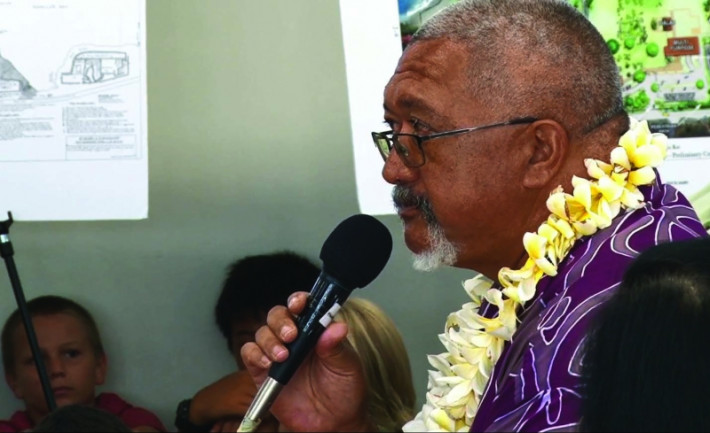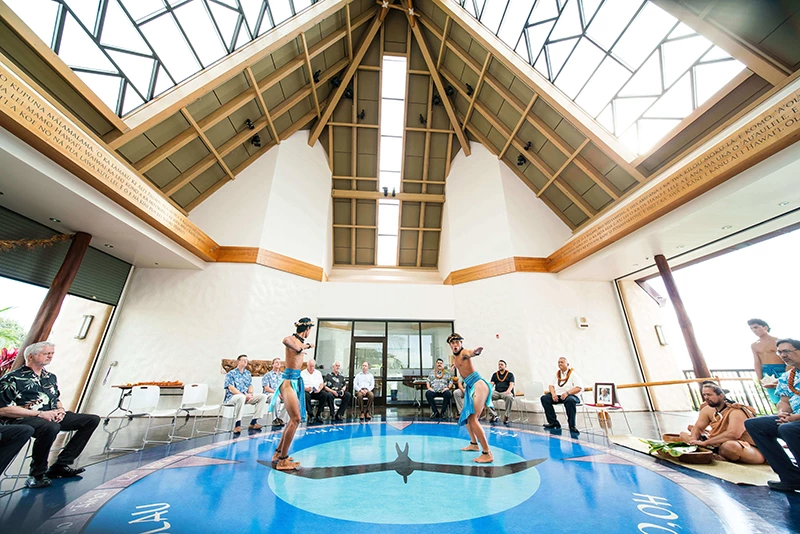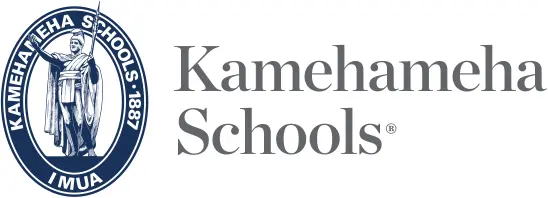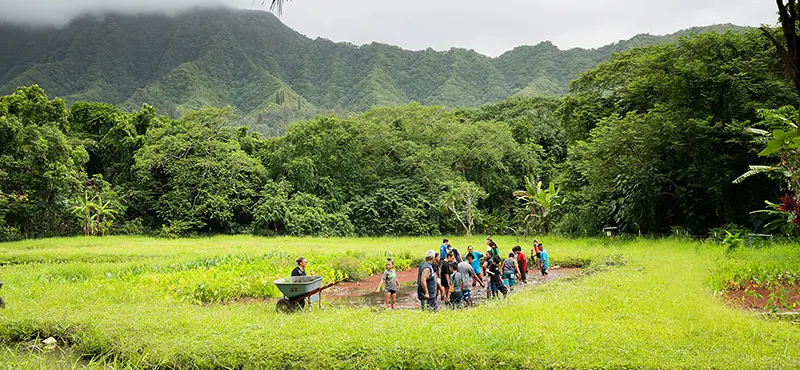Nearly 100 education and culture advocates from across Hawaiʻi island packed into a recent Leeward Planning Commission (LPC) public hearing to show their support for Kahaluʻu Ma Kai – a West Hawaiʻi learning complex planned by Kamehameha Schools (KS).
The purpose of the hearing was to gather public testimony on whether to grant KS a special management area (SMA) use permit for the shoreline site. The permit would allow KS contractors to remove the former Keauhou Beach Hotel to begin construction in the fall.
The creation of the learning complex is being guided by Kamehameha’s Strategic Plan 2015-2020. When complete, it will bring together the many facets of education in West Hawai‘i – with a focus on science, technology, engineering, arts and mathematics – and the region’s various learning entities into a unique community collaboration.
Those who shared supportive testimony at the hearing included representatives from the University of Hawai‘i at Hilo, the Community College at Palamanui, and two public charter schools. Also voicing their support were members of the Royal Order of Kamehameha, members of the Daughters of Hawai‘i, longtime residents of West Hawai‘i, and descendants of Kahalu‘u.
Among those testifying was master navigator ‘Ōnohi Paishon of Nā Kālai Wa‘a, a Hawaiʻi island organization that teaches traditional navigation of Polynesian voyaging canoes.
Paishon likened initial reactions to the 21st-century learning complex to the reaction raised by the building of a traditional voyaging canoe by the Polynesian Voyaging Society. His testimony demonstrated that innovative ideas can have extraordinary impact.
“It is no different in the sense of planning for all the voyages that we have now,” said Paishon. “At one time, there was a crazy idea of creating a canoe called Hōkūle‘a – a crazy idea that this canoe was going to retrace the path of our ancestors back to Tahiti without any modern instruments. From that one voyage, from that one crazy idea, that canoe now sits at Mauritius half way around the world.”
Kamehameha’s voyage to build its educational complex has raised community concerns relating to public shoreline access. Opponents of Kamehameha’s managed access plan assert that a new public pathway should be constructed to allow the public to walk from Kahalu‘u Beach Park on the north to Mākole‘ā Cove on the south.
Kaeo Duarte, KS vice president of Community Engagement and Resources, says that the trust has no plans to limit access to the beach.
“KS has not and will not prevent any lawful ma uka - ma kai or lateral public access along the public areas at the shoreline,” he said.
The proposed access plan is rooted in the region’s culture and history. For more than 18 generations, Kahalu‘u Ma Kai was the center of ali‘i learning and politics, so access to the area was restricted to the permission granted by ali‘i. KS proposes a balanced approach to public access that will uphold the rights of Hawaiian practioners and learners to engage in cultural education and activities, while allowing lawful access to the shoreline.
The access plan calls for full public access along the southern border of the nearly 23-acre property – a walkway that leads to the ocean from a public parking lot that KS will construct and maintain. It also includes a public path that will usher visitors from the main entrance to the middle of the project allowing them to view and learn about the area’s historical sites and cultural activities.
The managed access proposal was vetted in the project’s approved Environmental Assessment. It also aligns with the State Historic Preservation Division’s preservation plans and buffer zones for five heiau located on the site – Hale o Papa, Keʻekū, Hāpaialiʻi, Mākole‘ā, and Kapuanoni.
“We cannot compromise the safety of our learners, our keiki, and the protection and honor of the cultural sites at Kahalu‘u Ma Kai,” said Jamee Miller, KS interim senior director for West Hawai‘i and director of education initiatives for the region.
“To ensure that the architectural integrity of the cultural resources is protected and proper honor for these sites are preserved, we’re requesting that the LPC approves our proposed public access plan.”
Of the 24 people who testified at the LPC hearing, only two raised concerns relating to Kamehameha’s managed access plan. Sandra Kirkpatrick, an opponent of the plan, stated that she believes the general public has a right to access the heiau.
“That rich history is very much an asset, but not just an asset to the Kamehameha Schools,” said Kirkpatrick. “It’s an asset for everyone, and for that reason I think everyone should be allowed reasonable access. It definitely worries me about the school zone cutting off access completely.”
Like many in the audience, Carly Rose, a student of Kua o ka Lā public charter school disagreed.
“Having that pathway is like letting a whole bunch of tourists come through and watch what you’re doing and taking pictures of you like they’re at a museum,” said Rose. “Our school is right next to Ahalanui Park. There are people coming and taking pictures of us, and we have to go up to them and tell them to delete them.”
Citing a few “unresolved issues,” which include public shoreline access, the Hawaiʻi County Planning Department and Kamehameha Schools requested that the LPC continue the Kahalu‘u Ma Kai hearing at the next regularly scheduled LPC meeting on October 22.
“There’s no precedence for what we’re doing at Kahalu‘u Ma Kai, so it’s a new venture for all of us,” said Miller. “As we partner with county officials, the community, and our kūpuna to see the vision for this site through, Kamehameha is committed to continue doing what is pono for the process, the land and its people.”
For more information on Kahalu‘u Ma Kai, visit www.ksbe.edu/kahaluumakai. Those interested in showing support for the project may email ksinfo@ksbe.edu.

Chadd ‘Ōnohi Paishon, pwo navigator and Sr. captain of Nā Kālai Waʻa and Makaliʻi, demonstrates his support for KMK through his testimony.

More than 40 supporters from the Hawai‘i Academy of Arts and Sciences in Puna arrive at the hearing.

Kamehameha Schools’ proposed plan for managed public access depicted in blues and yellow.

Three student-leaders from the Hawai‘i Academy of Arts and Sciences provided supportive testimony on behalf of their 40 school mates at the LPC hearing.
Related stories
TAGS
kahaluu ma kai,
aina-based education,
education,
hawaiian culture based education,
ce&r,
community engagement and resources,
strategic plan,
keiki spring festival,
sp2020
CATEGORIES
Kaipuolono Article, Newsroom, Strategic Plan
Print with photos
Print text only










